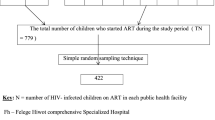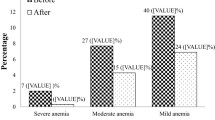Abstract
In this report, the prevalence and multifactorial etiology of anemia among Indian human immunodeficiency virus (HIV)-infected children are described. HIV-infected children aged 2–12 years were prospectively enrolled in 2007–2008. Measured parameters included serum ferritin, vitamin B12, red-cell folate, soluble transferrin receptor, and C-reactive protein. Children received antiretroviral therapy (ART), iron and, folate supplements as per standard of care. Among 80 enrolled HIV-infected children (mean age 6.8 years), the prevalence of anemia was 52.5%. Etiology of anemia was found to be iron deficiency alone in 38.1%, anemia of inflammation alone in 38.1%, combined iron deficiency and anemia of inflammation alone in 7.1%, vitamin B12 deficiency in 7.1%, and others in 9.5%. Median iron intake was 5.7 mg/day (recommended dietary allowance 18–26 mg/day). Compared to nonanemic children, anemic children were more likely to be underweight (weight Z-score −2.5 vs. -1.9), stunted (height Z-score −2.6 vs. -1.9), with lower CD4 counts (18% vs. 24%, p < 0.01), and higher log viral load (11.1 vs. 7.1, p < 0.01). Hemoglobin (Hb) improved significantly among those who started ART (baseline Hb 11.6 g/dl, 6-month Hb 12.2 g/dl, p = 0.03). Children taking ART combined with iron supplements experienced a larger increase in Hb compared to those receiving neither ART nor iron supplements (mean Hb change 1.5 g/dl, p < 0.01). Conclusion Anemia, particularly iron deficiency anemia and anemia of inflammation, is highly prevalent among children with HIV infection. Micronutrient supplements combined with ART improved anemia in HIV-infected children.

Similar content being viewed by others
Abbreviations
- HIV:
-
Human immunodeficiency virus
- ART:
-
Antiretroviral therapy
- WHO:
-
World Health Organization
- RDA:
-
Recommended dietary allowance
- CRP:
-
C-reactive protein
- sTfR:
-
Soluble transferrin receptor
- sTfR/f:
-
Soluble transferrin receptor/log ferritin index
References
Angeles Vazquez Lopez M, Molinos FL, Carmona ML, Morales AC, Munoz Vico FJ, Munoz JL, Munoz Hoyos A (2006) Serum transferrin receptor in children: usefulness for determinating the nature of anemia in infection. J Pediatr Hematol Oncol 28(12):809–815
Bal AM, Lakhashe SK, Thakar MR, Tripathy SP, Paranjape RS (2005) Dysregulation of proinflammatory and regulatory cytokines in HIV infected persons with active tuberculosis. Cytokine 30(5):275–281
Bharathi AV, Kurpad AV, Thomas T, Yusuf S, Saraswathi G, Vaz M (2008) Development of food frequency questionnaires and a nutrient database for the Prospective Urban and Rural Epidemiological (PURE) pilot study in South India: methodological issues. Asia Pac J Clin Nutr 17(1):178–185
Boelaert JR, Weinberg GA, Weinberg ED (1996) Altered iron metabolism in HIV infection: mechanisms, possible consequences, and proposals for management. Infect Agents Dis 5(1):36–46
Calis JC, van Hensbroek MB, de Haan RJ, Moons P, Brabin BJ, Bates I (2008) HIV-associated anemia in children: a systematic review from a global perspective. AIDS 22(10):1099–1112
Clark TD, Mmiro F, Ndugwa C, Perry RT, Jackson JB, Melikian G, Semba RD (2002) Risk factors and cumulative incidence of anaemia among human immunodeficiency virus-infected children in Uganda. Ann Trop Paediatr 22(1):11–17
de Monye C, Karcher DS, Boelaert JR, Gordeuk VR (1999) Bone marrow macrophage iron grade and survival of HIV-seropositive patients. AIDS 13(3):375–380
Ekiz C, Agaoglu L, Karakas Z, Gurel N, Yalcin I (2005) The effect of iron deficiency anemia on the function of the immune system. Hematol J 5(7):579–583
Eley BS, Sive AA, Shuttleworth M, Hussey GD (2002) A prospective, cross-sectional study of anaemia and peripheral iron status in antiretroviral naive, HIV-1 infected children in Cape Town, South Africa. BMC Infect Dis 2(1):3
Ellaurie M, Burns ER, Rubinstein A (1990) Hematologic manifestations in pediatric HIV infection: severe anemia as a prognostic factor. Am J Pediatr Hematol Oncol 12(4):449–453
Fawzi WW, Msamanga GI, Spiegelman D, Wei R, Kapiga S, Villamor E, Mwakagile D, Mugusi F, Hertzmark E, Essex M, Hunter DJ (2004) A randomized trial of multivitamin supplements and HIV disease progression and mortality. N Engl J Med 351(1):23–32
Georgiou NA, van der Bruggen T, Oudshoorn M, Nottet HS, Marx JJ, van Asbeck BS (2000) Inhibition of human immunodeficiency virus type 1 replication in human mononuclear blood cells by the iron chelators deferoxamine, deferiprone, and bleomycin. J Infect Dis 181(2):484–490
Gopalan C, Rama Sastri BV, Balasubramanian SC SC, Narasinga Rao BS, Deosthale YG, Pant KC (1996) Nutritive value of Indian foods. National Institute of Nutrition (ICMR), Hyderabad
Hilgartner M (1991) Guidelines for the care of children and adolescents with HIV infection. Hematologic manifestations in HIV-infected children. J Pediatr 119(1 Pt 2):S47–S49
Indian Council of Medical Research (ICMR) (2000) Iron absorption and its implications on strategies to control iron deficiency anaemia. ICMR Bull 30(2). Available at http://icmr.nic.in/bufeb00.pdf
Kapur D, Sharma S, Agarwal KN (2005) Dietary intake and growth pattern of children 9–36 months of age in an urban slum in Delhi. Indian Pediatr 42(4):351–356
Kupka R, Msamanga GI, Mugusi F, Petraro P, Hunter DJ, Fawzi WW (2007) Iron status is an important cause of anemia in HIV-infected Tanzanian women but is not related to accelerated HIV disease progression. J Nutr 137(10):2317–2323
Lee EJ, Oh EJ, Park YJ, Lee HK, Kim BK (2002) Soluble transferrin receptor (sTfR), ferritin, and sTfR/log ferritin index in anemic patients with nonhematologic malignancy and chronic inflammation. Clin Chem 48(7):1118–1121
Malik ZA, Abadi J, Sansary J, Rosenberg M (2009) Elevated levels of vitamin B12 and folate in vertically infected children with HIV-1. AIDS 23(3):403–407
Merchant RH, Oswal JS, Bhagwat RV, Karkare J (2001) Clinical profile of HIV infection. Indian Pediatr 38(3):239–246
Mildvan D, Creagh T, Leitz G (2007) Prevalence of anemia and correlation with biomarkers and specific antiretroviral regimens in 9690 human-immunodeficiency-virus-infected patients: findings of the Anemia Prevalence Study. Curr Med Res Opin 23(2):343–355
Ministry of Health and Family Welfare, Government of India (2007) National Family Health Survey (NFHS-3) 2005–06: key findings. International Institute for Population Sciences, Mumbai. http://www.measuredhs.com/pubs/pdf/SR128/SR128.pdf. Accessed on 17 November 2008
Mocroft A, Kirk O, Barton SE, Dietrich M, Proenca R, Colebunders R, Pradier C, dArminio Monforte A, Ledergerber B, Lundgren JD (1999) Anaemia is an independent predictive marker for clinical prognosis in HIV-infected patients from across Europe. EuroSIDA study group. AIDS 13(8):943–950
Muthayya S, Thankachan P, Zimmermann MB, Andersson M, Eilander A, Misquith D, Hurrell RF, Kurpad AV (2007) Low anemia prevalence in school-aged children in Bangalore, South India: possible effect of school health initiatives. Eur J Clin Nutr 61(7):865–869
National AIDS Control Organization (2006) Guidelines for HIV Care and treatment in infants and children. Available at http://www.nacoonline.org/Quick_Links/Publication/Treatment_Care__Support/Operational__Technical_guidelines_and_policies/Guidelines_for_HIV_Care_and_Treatment/
National AIDS Control Organization (2010). HIV/AIDS estimates, 2010 http://www.nacoonline.org
Nemeth E, Rivera S, Gabayan V, Keller C, Taudorf S, Pedersen BK, Ganz T (2004) IL-6 mediates hypoferremia of inflammation by inducing the synthesis of the iron regulatory hormone hepcidin. J Clin Invest 113(9):1271–1276
Nemeth E, Valore EV, Territo M, Schiller G, Lichtenstein A, Ganz T (2003) Hepcidin, a putative mediator of anemia of inflammation, is a type II acute-phase protein. Blood 101(7):2461–2463
Nicolas G, Chauvet C, Viatte L, Danan JL, Bigard X, Devaux I, Beaumont C, Kahn A, Vaulont S (2002) The gene encoding the iron regulatory peptide hepcidin is regulated by anemia, hypoxia, and inflammation. J Clin Invest 110(7):1037–1044
Osei A, Houser R, Bulusu S, Joshi T, Hamer D (2010) Nutritional status of primary schoolchildren in Garhwali Himalayan villages of India. Food Nutr Bull 31(2):221–233
Pasricha SR, Black J, Muthayya S, Shet A, Bhat V, Nagaraj S, Prashanth NS, Sudarshan H, Biggs BA, Shet AS (2010) Determinants of anemia among young children in rural India. Pediatrics 126(1):e140–e149
Pfeiffer CM, Johnson CL, Jain RB, Yetley EA, Picciano MF, Rader JI, Fisher KD, Mulinare J, Osterloh JD (2007) Trends in blood folate and vitamin B-12 concentrations in the United States, 1988 2004. Am J Clin Nutr 86(3):718–727
Punnonen K, Irjala K, Rajamaki A (1997) Serum transferrin receptor and its ratio to serum ferritin in the diagnosis of iron deficiency. Blood 89(3):1052–1057
Rajasekaran S, Jeyaseelan L, Ravichandran N, Gomathi C, Thara F, Chandrasekar C (2009) Efficacy of antiretroviral therapy program in children in India: prognostic factors and survival analysis. J Trop Pediatr 55(4):225–232
Rawat R, Humphrey JH, Ntozini R, Mutasa K, Iliff PJ, Stoltzfus RJ (2009) Elevated iron stores are associated with HIV disease severity and mortality among postpartum women in Zimbabwe. Public Health Nutr 12(9):1321–1329
Ray A, Ndugwa C, Mmirot F, Ricks MO, Semba RD (2007) Soluble transferrin receptor as an indicator of iron deficiency in HIV-infected infants. Ann Trop Paediatr 27(1):11–16
Salhi Y, Costagliola D, Rebulla P, Dessi C, Karagiorga M, Lena-Russo D, de Montalembert M, Girot R (1998) Serum ferritin, desferrioxamine, and evolution of HIV-1 infection in thalassemic patients. J Acquir Immune Defic Syndr Hum Retrovirol 18(5):473–478
Sappey C, Boelaert JR, Legrand-Poels S, Forceille C, Favier A, Piette J (1995) Iron chelation decreases NF-kappa B and HIV type 1 activation due to oxidative stress. AIDS Res Hum Retroviruses 11(9):1049–1061
Semba RD (2003) Iron-deficiency anemia and the cycle of poverty among human immunodeficiency virus-infected women in the inner city. Clin Infect Dis 37(Suppl 2):S105–S111
Semba RD, Broadhead R, Taha TE, Totin D, Ricks MO, Kumwenda N (2001) Erythropoietin response to anemia among human immunodeficiency virus-infected infants in Malawi. Haematologica 86(11):1221–1222
Semba RD, Gray GE (2001) Pathogenesis of anemia during human immunodeficiency virus infection. J Investig Med 49(3):225–239
Shah SR, Tullu MS, Kamat JR (2005) Clinical profile of pediatric HIV infection from India. Arch Med Res 36(1):24–31
Shet A, Mehta S, Rajagopalan N, Dinakar C, Ramesh E, Samuel NM, Indumathi CK, Fawzi WW, Kurpad AV (2009) Anemia and growth failure among HIV-infected children in India: a retrospective analysis. BMC Pediatr 9:37
Stoltzfus R, Dreyfus ML (1998) In: INACG, WHO, UNICEF (eds) Guidelines for the use of iron supplements to prevent and treat iron deficiency anemia. Washington, IUNACG
Sullivan PS, Hanson DL, Chu SY, Jones JL, Ward JW (1998) Epidemiology of anemia in human immunodeficiency virus (HIV)-infected persons: results from the multistate adult and adolescent spectrum of HIV disease surveillance project. Blood 91(1):301–308
Taneja S, Bhandari N, Strand TA, Sommerfelt H, Refsum H, Ueland PM, Schneede J, Bahl R, Bhan MK (2007) Cobalamin and folate status in infants and young children in a low-to-middle income community in India. Am J Clin Nutr 86(5):1302–1309
Totin D, Ndugwa C, Mmiro F, Perry RT, Jackson JB, Semba RD (2002) Iron deficiency anemia is highly prevalent among human immunodeficiency virus-infected and uninfected infants in Uganda. J Nutr 132(3):423–429
van Lettow M, van der Meer JW, West CE, van Crevel R, Semba RD (2005) Interleukin-6 and human immunodeficiency virus load, but not plasma leptin concentration, predict anorexia and wasting in adults with pulmonary tuberculosis in Malawi. J Clin Endocrinol Metab 90(8):4771–4776
Weinstein DA, Roy CN, Fleming MD, Loda MF, Wolfsdorf JI, Andrews NC (2002) Inappropriate expression of hepcidin is associated with iron refractory anemia: implications for the anemia of chronic disease. Blood 100(10):3776–3781
Weiss G, Goodnough LT (2005) Anemia of chronic disease. N Engl J Med 352(10):1011–1023
WHO (2001) Iron deficiency anaemia assessment, prevention, and control. A guide for programme managers. WHO/NHD/01.3. World Health Organization, Geneva. Accessible at http://www.who.int/nutrition/publications/micronutrients/anaemia_iron_deficiency/WHO_NHD_01.3/en/index.html
WHO (2004) Iron supplementation of young children in regions where malaria transmission is intense and infectious disease highly prevalent. Report of the meeting to review results of the zinc/iron supplementation trials conducted in Nepal and Tanzania–Zanzibar, Tanzania, 30 April–1 May 2004. WHO Statement. http://www.who.int/childadolescent-health/-New_Publications/CHILD_HEALTH/WHO_FCH_CAH_06.2.pdf
Acknowledgments
The authors gratefully acknowledge the staff of the Pediatric and Infectious Diseases clinic at St. John’s Hospital for their assistance with patient care. The authors also thank the National AIDS Control Organization of India for its support to this work and for providing free ART for the patients. This work was partially supported by the International Nutrition Foundation/Ellison Medical Foundation Fellowship Award as well as the Child Health Foundation Grant awarded to AS.
The results of this study were presented in part at the World Public Health Nutrition Congress in Porto, Portugal, on 23–26 September, 2010.
Conflict of Interest
None
Author information
Authors and Affiliations
Corresponding author
Rights and permissions
About this article
Cite this article
Shet, A., Arumugam, K., Rajagopalan, N. et al. The prevalence and etiology of anemia among HIV-infected children in India. Eur J Pediatr 171, 531–540 (2012). https://doi.org/10.1007/s00431-011-1599-y
Received:
Accepted:
Published:
Issue Date:
DOI: https://doi.org/10.1007/s00431-011-1599-y




